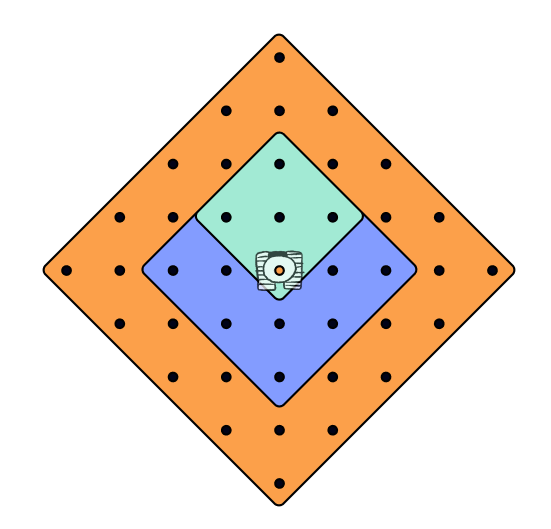我最近在 brillant.org 的 Instagram 帐户上看到了一张挑战照片:
说明: 机器人随机走 4 步(不能走对 Angular 线)。
最有可能降落在哪个区域?
显然,机器人有 44 = 256 条可能的路径。 我尝试编写一个程序(Javascript)来解决该问题,但我的方法不起作用。 实际上,我没有在这里展示有用的代码,因为我很早就陷入了困境。
所以我的问题是: 您将如何编写一个程序来:
检查所有 256 条可能的路径
告诉我有多少 (%) 降落在哪个区域
最佳答案
这是一个非常酷的问题! 感谢您让我发现了 brillant.org 的 Instagram 帐户。 因此,我将按以下步骤进行:
- 编写一个函数来计算所有可能的重复排列 (n^k)
- 生成一个 map ,在其中执行第 1 步中计算出的所有可能的移动
- 检查机器人最后一步将着陆的区域并将其存放
- 根据第 3 步中的计数计算百分比
第一步本身就是一个问题,它不属于这个范围。您可以在此处使用或修改代码:https://rosettacode.org/wiki/Permutations_with_repetitions
然后,为了生成 map ,我简单地使用了一个数组:
const map = [
0, 0, 0, 0, 1, 0, 0, 0, 0,
0, 0, 0, 1, 1, 1, 0, 0, 0,
0, 0, 1, 1, 2, 1, 1, 0, 0,
0, 1, 1, 2, 2, 2, 1, 1, 0,
1, 1, 3, 3, 2, 3, 3, 1, 1,
0, 1, 1, 3, 3, 3, 1, 1, 0,
0, 0, 1, 1, 3, 1, 1, 0, 0,
0, 0, 0, 1, 1, 1, 0, 0, 0,
0, 0, 0, 0, 1, 0, 0, 0, 0,
];
这是您提供的图像的表示,每个区域都标有不同的数字,我们稍后将重复使用。
此时我定义了一个包含 4 种可能的移动的数组:
const moves = [
-1, // left
1, // right,
-9, // top
9, // bottom
];
这些值表示沿注释中写入的方向移动所需的偏移量:我想左和右是不言自明的。对于顶部和底部,由于我们使用数组作为“矩阵”,因此我们基本上需要将 y 值转换为数组中的索引值。公式很简单:index = x + y * width,这意味着如果您想指定 y 来向上移动一个单元格您有 -1 * 9,向下 移动是 1 * 9。
出于同样的原因,机器人的起始位置(在 map 中心)计算如下:4 + 4 * 9。
现在我用排列函数计算所有可能的移动组合:
const allmoves = permutationsWithRepetition(4, moves);
并创建一个数组来存储结果:
let results = [0, 0, 0, 0];
之后,我只是迭代所有可能的移动数组,并计算移动结束时的位置:
for (let j = 0; j < allmoves.length; j++) {
// set the robot's initial position at the center
// before executing any moves' list
let pos = 4 + 4 * 9;
// calculate the new position using the current moves
for (let i = 0; i < moves.length; i++) {
let move = allmoves[j][i];
pos += move;
}
// now `map[pos]` points to a number between 1 and 3
// that identify the area where the robot is.
// we use that number as index of the results
// to increment its value.
// Notice that it's impossible land to any 0 area
// if we start from the center and we can only perform
// 4 moves.
// We use that number as `index` for our `results`
results[map[pos]]++;
}
现在在结果中,您将看到机器人最终到达哪个区域的次数:
console.log(results); // [0, 60, 100, 96]
如上所述,给定起始位置和机器人在任何 0 区域着陆的移动次数是不可能的,因此第一个索引的值将为 0。
您可以看到它在区域 1(橙色区域)着陆了 60 次,在区域 2 100 次(最小区域,绿色/浅绿色区域),在区域 3 区域着陆了 96 次(蓝色/紫色区域) )。
此时您可以计算百分比(次/总计 * 100)并以正确的格式显示:
// we skip the first element of results since
// it's not an area (and we'll be always 0)
for (let k = 1; k < results.length; k++) {
console.log(k, `${(results[k] / allmoves.length * 100).toFixed(2)}%`)
}
你会得到:
1 "23.44%"
2 "39.06%"
3 "37.50%"
您还可以进行经验检查,实际上随机生成一万个移动,并使程序应用这些移动而不是所有移动,您会发现最终总是以相似的数字结束(显然,但这也是数学的有趣部分,请验证这确实是您所期望的!)。
这里的工作代码也实现了 permutation code在开头提到的,来自rosettacode.org,以及这篇文章中解释的代码:https://codepen.io/zer0/pen/RwWPZmE
(需要打开控制台才能看到结果)
关于javascript - 如何计算网格上所有可能的路径,我们在Stack Overflow上找到一个类似的问题: https://stackoverflow.com/questions/61179453/
